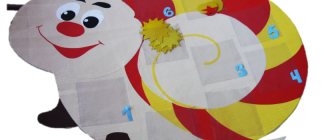Game-Exercise No. 1. Work on memorizing words and terms (their graphic version)
Make up vocabulary words (or terms, for adult listeners) from syllables, circle them in different colors.
Speech material for first-graders: alphabet, crow, law, came in, they are calling, textbook, teacher, glue, carpet.
Speech material for cadets and listeners on terminology (example): analysis, synthesis, verification, safety, accident, gaff, car pump, liquidation, arson.
! If possible, use word breakdowns or insert pictures and other visual cues to enhance comprehension.
Dysgraphia
- Specially selected speech material is also used to practice problem areas in writing and exercises for correction:
1. Clap or tap out the word syllable by syllable and name their number.
2. Be able to identify vowel sounds in a word, learn the basic rule of syllabic division: there are as many syllables in a word as there are vowel sounds.
3. Be able to isolate a vowel sound from a syllable and word. Determine the vowel sound and its place in the word (beginning, middle, end of the word).
4. Name the vowels in the word.
5. Write down only the vowels of the given word.
6. Select vowel sounds and find the corresponding letters.
7. Repeat the word syllable by syllable. Count the number of syllables.
8. Determine the number of syllables in the named words. Raise the corresponding number.
9. Write down the words in two columns (split the pictures into 2 groups) depending on the number of syllables.
10. Select the first syllable from the names of the pictures and write it down.
11. Combine syllables in a word, sentence, read the resulting word or sentence (for example: “beehive”, “house”, “car”, “moon”, “toad”). After highlighting the first syllables, the sentence is obtained: There is a puddle near the house.
12. Identify the missing syllable in a word using a picture:
__buzz, ut__, lod__, ka__, ka__dash.
13. Compose a word from syllables given in disorder (nok, tsyn, las, toch, forest, ka).
14. Find words in a sentence with a certain number of syllables.
Game “Guess who I'm calling?”
Goal: developing the ability to select words with a given number of syllables.
The teacher invites those children whose names consist of as many syllables to stand up as he claps.
For example: the teacher claps 3 times, the students count, then stand up (Se-ryo-zha, A-ri-na).
Game “Changes”.
Goals: development of the ability to compose words; accumulation of syllable images in memory.
Equipment: cards with syllables (4–6) for each player.
The teacher names two syllables, the children find cards with these syllables and first compose one word, then, rearranging the syllables, another: sos, na; tea. CA; spring; kA, mouse; jar; la, ska”ni, tka; ra. But; Which.
Game “Chain”.
Goal: developing the ability to select words based on one given syllable.
One of the students writes a word on the board syllable by syllable, the next one selects a word that begins with the next syllable of the given word (ok-no, no-ra, ra-ma).
Game “If I meet a word on the road, I’ll break it into syllables.”
Goal: development of syllable skills, attention, speed of thinking.
The teacher throws a ball to the children and names one-, two- and three-syllable words. The child who catches the ball determines the number of syllables, names them and passes the ball back. You can invite children to pronounce the word syllable by syllable while simultaneously hitting the word with a ball.
Game "Name of a fairy-tale character"
Goal: improving the skills of syllabic analysis and synthesis.
Objectives: develop phonemic hearing; Exercise students in the ability to divide words into syllables.
Equipment: cards with a set of words.
Fairy tale character name
Game-Exercise No. 2. We work on word order to help the child/adult understand the text.
Option for children.
Adding one word at a time, make sentences based on the picture. Be sure to ensure that your child follows word order.
Picture for the exercise
LENA IS RIDING.
____ _____ on ________
____ _____ us____.
_____ _____ us ____ ____.
Option for adult learners.
The rules of the game are simple, but you will need some equipment - special cards. In general, there is a real game, it is called Dixit, but not everyone can afford to buy it. Therefore, you can create some of its elements yourself. The bottom line is this: players are dealt six cards. They depict various pictures - almost surrealism.
For example , a rickety anchor in the middle of the desert.
Example of cards for the game
The essence of the exercise game
- What associations come to mind?
- They need to be formulated in one phrase - and voiced by others.
- The main condition: the phrase must be constructed in compliance with the word order. Inversion and illogicality are unacceptable.
- Players select a suitable card from their set according to the description and place it on the table.
The secret is that the description must be multifaceted, and the one whose card is not immediately guessed wins.
- But, the important element is that if no one could identify your card at all, you lose points.
- By the way, the cards themselves, or rather the pictures, can be found and printed from the Internet at home.
What are the causes of dysgraphia?
The correct writing of words and the expression of one’s thoughts on paper largely depend on the correct formation of oral speech.
There are 2 groups of causes of dysgraphia:
- Diseases suffered at different stages of the development of the nervous system and brain. These include maternal illness during pregnancy, birth injuries, further serious infections and damage to vital organs.
- Social and psychological: communication with people who have pronunciation defects, learning several languages from early childhood (for example, in bilingual families), lack of correction of speech errors by parents.
These factors often lead to the formation of non-standard sound pronunciation and sound perception (phonemic hearing), and negatively affect the lexical, grammatical and coherent components of the child’s speech.
Methods for identifying dysgraphia
Identification of dysgraphia is a complex process, which is based on solving the following problems:
- Distinguish an illness from ignorance of the rules of spelling words.
- Distinguish between this type of disorder and pathologies of the organs of vision, hearing, and ENT organs.
- Determine the form of the disease.
If there is a suspicion that a child has a pathology, you should consult with specialists:
- ophthalmologist - will see eye diseases and cerebral circulation disorders;
- otolaryngologist – examines for diseases of the throat, ears and nose;
- the dentist will see defects in the structure of the teeth, which may interfere with the correct pronunciation of words and indirectly contribute to their illiterate spelling;
- neurologist - will determine the state of the central nervous system and the problems existing in this area;
- speech therapist - will identify the presence of oral speech defects and their relationship with errors in writing, determine the type of dysgraphia.
The main stages of diagnosing dysgraphia are:
- Research of written works.
- Study of the patient’s physical, mental, speech development, condition of the organs of vision and hearing.
- Examination of the articular apparatus, manual and speech motor skills, determination of the dominant hand.
- Study of the level of sound perception, sound pronunciation, vocabulary of the child, knowledge and use of lexical and grammatical basics.
- Conducting a writing test.
Written language analysis involves identifying the disorder by presenting the child with various written tasks, after which a verdict is made. Types of written tasks for diagnosing dysgraphia: copying from handwritten and printed texts, describing pictures, dictations, tests.
In preschool children, the risk of subsequent problems with writing is identified by the quality of their drawings. Potential dysgraphics aged 3-6 years are drawn reluctantly, with uneven lines, abruptly, and unclearly. This is often due to undeveloped finger muscles and poorly developed hand motor skills.
What types of dysgraphia are there?
Generally, there are three types of dysgraphia, which each have their own symptoms.
- Spatial dysgraphia. A child with this type of dysgraphia does not have spelling errors in written text. Difficulties arise when copying or rewriting other texts. In addition, difficulties with drawing are noticeable.
- Dysgraphia dyslexia . It is characterized by the fact that the text of a person who suffers from this disease is full of spelling errors. Usually the sounds at the end of a word become dull; the child “writes as he hears.” There are no problems with rewriting and copying other texts. Drawing is also easy.
- Motor dysgraphia. A child suffering from a movement disorder mainly has problems with writing texts. The lack of coordination of movements is clearly expressed, and the copied text contains many errors.
Methods for correcting dysgraphia
The method of correction depends on the severity of the child’s written language impairment. In addition, the method of treating the deviation is influenced by the degree of neglect, as well as the characteristics of the patient. Correction is a long and complex process that requires persistence on the part of teachers and parents, patience, endurance and a positive attitude of the patient. If you follow all the necessary recommendations, dysgraphia can be completely cured. It is better if the disorder is diagnosed at an earlier age, since the course of correction for older schoolchildren is longer due to the presence in most cases of additional speech and writing disorders. In this case, the time required for rehabilitation will take more. There is also a high risk that the violation cannot be eliminated completely.
It is impossible to get rid of dysgraphia on your own. This process requires the participation of many highly specialized specialists, for example, a psychologist, a neuropsychologist. However, the main work falls on the speech therapist, who will have to select a rehabilitation program appropriate to the severity of the disease and the individual characteristics of the patient. The specialist individually selects the necessary sound pronunciation exercises. Classes are aimed at improving motor skills, developing the patient’s lexical and grammatical structure, as well as improving phonemic speech recognition.
Methods for correcting dysgraphia, which are among the most effective:
- Exercises through which the patient learns to correctly understand sounds, words, and letters.
- Tasks aimed at training memory, improving thinking, and developing perception.
- Exercises necessary for the patient to learn to correctly recognize letters that are similar in appearance.
- Proper production of sounds, work on speech automation.
- Educational games to improve sound analysis.
In some cases, specialists include drug treatment, physiotherapy, massage, and exercise therapy in the rehabilitation course. This often applies to patients whose dysgraphia was caused by organic causes. It is important to know that drug treatment should be prescribed exclusively by a qualified specialist.
Speech therapy correction
Auditory differentiation of sounds is what needs to be achieved initially when treating dysgraphia. If a child cannot distinguish sounds, then further exercises will not be effective. The rehabilitation period is determined individually and depends on many factors. Classes with a speech therapist are possible both in a group with other children and individually. It depends on the wishes of the child and his parents.
During classes, the speech therapist gives the child verbal and visual exercises, as well as practical lessons, during which correctional work takes place.
Exercises you can do at home
Since it is impossible to get rid of dysgraphia on your own, experts, in addition to basic classes, recommend doing additional exercises at home to consolidate the results obtained with a speech therapist.
Exercises that can be done at home should also be agreed upon with a speech therapist. It is important that parents supervise the technique and regularity of classes. The simplest but most effective exercises that you can do at home with your parents include:
- Labyrinth. The child draws a line on a piece of paper, moving only his hand. You cannot make breaks or change the position of the sheet.
- Search for objects or pictures. The child searches for and paints the objects found.
- Exercises aimed at developing attention. The child must read the text and look for missing letters or words, writing them in the right places.
- Improved articulation. The child learns songs, rhymes, and tongue twisters.
- Logorhythmics.
To get a positive result as quickly as possible, home exercises should be performed regularly. This will significantly shorten the rehabilitation period.
Testing to determine dysgraphia in a child
Testing is considered an effective method for identifying writing disorders in primary school students. Tests can be compiled general or for specific types of dysgraphia.
They allow you to learn the following child skills:
- perceive words, phrases, sentences by ear and write them down;
- divide words into syllables and sentences into words;
- correctly identify sounds;
- connect words by gender, number, case;
- make up words and phrases;
Test execution rules:
- Compliance with the established sequence of test tasks.
- If there are any missed items, you need to return to them after completing the test.
Example of test tasks:
- Make up a phrase using the word in brackets in the correct form:
a) buy a (guinea)__________ pig; b) take (sticky)__________dough; c) get a (solid)_________A.
- Can you form a word from the given letters?
a) KOSHLA; b) CHEBUKIN; c) MONLEY.
- Cross out the syllable indicated in brackets on the line:
a) (pi) neither ip pi nor il pi ip; b) (shu) shu shu ush ush tsu do shu schu; c) (ah) oh cool as much oh ah ah as much as oh ah cool.
Often, tests to determine dysgraphia include dictations, as well as analysis of visual aids (pictures with letters, syllables, drawings).
The conclusion is made not only based on the test results, but also on the speed at which the student completes tasks. Children with writing impairments complete each block slowly, and the design of the work usually contains numerous crossed-outs.
Prevention of dysgraphia
Experts cannot name the exact causes of dysgraphia. In addition, it is believed that such a violation of written speech cannot be prevented. However, there are known risk groups whose representatives more often suffer from the presence of such a deviation. This:
- Bilingual children;
- Patients with mental retardation
- Children who were retrained to write with their right hand
- Hyperactive children
- Children who started learning too early
Prevention measures include training memory and attentiveness, increasing vocabulary. It is important to know that if a child constantly makes the same mistakes when writing words, there is no need to postpone visiting a speech therapist until later. If a child has a written speech disorder, the sooner correctional work is started, the faster and easier it will be to get rid of the problem, which is fraught with serious consequences for the child in the future.
Dysgraphia and ugly writing
It happens that a child has ugly handwriting, but the features attributed to dysgraphia do not appear. We are talking in particular about slanted, overlapping or large letters, as well as the difficulties of combining them.
Children or adults who do not have signs of dysgraphia and have unsightly handwriting can improve their skills. Calligraphy master classes have become very popular lately. If you have decided not to send your child to such classes, then you should study with him at home. Exercise will definitely bring beneficial effects.
To improve a parent's or child's writing skills, it is important to use professional and trusted sources.




